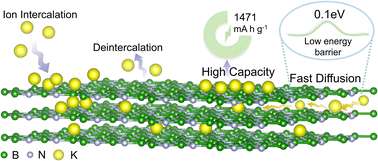First principles study of B7N5 as a high capacity electrode material for K-ion batteries†
Abstract
Potassium-ion batteries (KIBs) are considered a promising candidate for energy storage owing to their low cost and similar “rocking chair” mechanism to lithium-ion batteries. However, there is a great lack of suitable and high working performance electrode materials for KIBs. Herein, first principles calculations based on density functional theory (DFT) are applied to evaluate the potential of the B7N5 monolayer as an anode material for KIBs. It is found that B7N5 shows negative adsorption energies for Li/Na/K on its surface. Besides, the B7N5 monolayer can effectively achieve double-layer adsorption for K atoms on both sides of the monolayer surface, while one-layer adsorption for Li and Na. Thus, B7N5 exhibits an ultra-high theoretical capacity of 1471.5 mA h g−1 for KIBs, which is almost the highest value for the anode materials reported in the literature. And the attractive capacity for KIBs is mainly contributed by the multiple empty electron orbitals of the constituting elements of B7N5 and the small distance mismatch. In addition, K atoms display high diffusivities on B7N5 with low energy barriers of 0.10 eV, and the open circuit voltages of 0.14 V for KIBs are also smaller compared with previous research. It is also shown that after adsorbing K, the semiconducting B7N5 monolayer is transformed to a metallic state with good conductivity. Furthermore, despite the large size of K+, the maximum change in the lattice constant of B7N5 is only 1.32%, indicating structural stability and ensuring good cycling stability for KIBs. The above-mentioned results suggest that B7N5 is a potential anode material for KIBs.

- This article is part of the themed collection: 2023 PCCP HOT Articles


 Please wait while we load your content...
Please wait while we load your content...